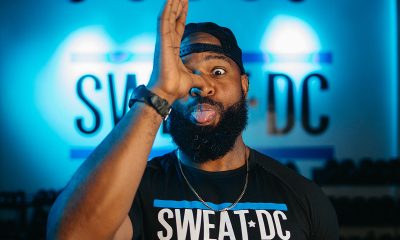Living
Kroell prepares to bare it all for Playgirl
Gay model coming to Baltimore for ‘Hunks in Trunks’ fundraiser

After competing on Bravo’s “Make Me a Supermodel,” contestant Ronnie Kroell made the move from Chicago to New York City where he continues to model and to pursue a career in acting. He also contributes to philanthropic ventures for several causes. Kroell recently agreed to appear nude in the June 2010 issue of Playgirl. Kroell will be in Baltimore on Thursday, May 20 for the all-male swimsuit fashion show, Hunks in Trunks.
The Washington Blade talked with Ronnie about his life in New York City, his philanthropic work, posing for Playgirl and more.
Washington Blade: Since you competed on “Make Me a Supermodel” you have moved to New York City, what has life been like for you after the move?
Ronnie Kroell: You could say it’s a dream come true. Following “Make Me a Supermodel,” which I can’t believe was over two years ago, I went through a scary time because I moved from Chicago to New York to follow “the dream” and not really knowing what I was getting myself into and I didn’t have any safety nets to catch me if I fell.
Coming to New York City was one of the best decisions I think I’ve ever made in my career. I love the city and all it has to offer and I take it one day at a time. I’m working hard at my passion, which is primarily the fashion industry and modeling but also expanding into the acting arena and being a humanitarian. I’m trying to get as involved as possible with the charities I think need the most help and that I feel are the closest to my heart.
Blade: You participated in Fashion Week in New York in February. Can you give a few details of your experience?
Kroell: There is nothing more thrilling than fashion week in New York. I love to be under the tents in Bryant Park, although this was the last year to be held in Bryant Park. The entire event is being moved to Lincoln Center for September’s Fashion Week. I especially love seeing designers like Malan Breton, Christian Siriano and other designers that are really making names for themselves. I feel really close with Malan because he and I shared in the same experience because we were part of the Bravo TV family. As passionate as he is as a designer and having that incredible opportunity to be on Bravo’s “Project Runway,” there are a lot of challenges to overcome from being on a reality show like that to then become a legitimate designer and be taken seriously.
I was also able to participate in Naomi Campbell’s Relief for Haiti event, which was so much fun. You really won’t find a community that is more dedicated and more passionate about getting involved when such major disasters happen or when there is a need to help other humans American or otherwise. The fashion community is really tight knit and comes together in such a huge way and raises awareness and the money it takes to help.
Blade: Which charities have you been focused on lately?
Kroell: Right now I’m working with a charity out of Africa called Womankind. What they do is try and protect women’s rights and are trying to prevent female genital mutilation in Africa. My business partner is a member of the board of this not-for-profit and we are hosting a charity event here in New York City on June 7 at La Palm to benefit Womankind. I’ve also been really involved with GLAAD, HRC, and the ACLU in various ways.
Blade: Speaking of GLAAD, you recently attended the GLAAD Media Awards. Describe your experience at the event.
Kroell: The GLAAD Media Awards were phenomenal! It’s incredible the work that GLAAD is doing and I know they just transitioned to their new president, Jarrett Barrios. GLAAD is working so hard and really revamped their image in the community and they’re really a watchdog and are increasingly so. They make sure the LGBT community is fairly represented in media and that the people that are doing a great job are rewarded for their contributions.
It was just so fun to meet people like Sigourney Weaver, Joy Behar and Cynthia Nixon. They are the most humble people who are in positions to really bring home the message of equality and take the stance that we are all human beings first and that hopefully one day we can get beyond the labels of sexual orientation. It’s inspiring to me because I have nowhere near the career that some of these people have so I’m learning from them, they’re my role models. Having the chance to be in the same room with them, listen to their stories, and hear about the work they’re doing inspires me to continue to do the things that I love to do.
Blade: You’re going to be in Baltimore on May 20 for the “Hunks in Trunks” fashion show, which benefits Equality Maryland. How will you be participating in the show?
Kroell: I got involved with Hunks in Trunks last year thanks to my friend Ted Hart who is one of the lead organizers of the event each year. I was really impressed with the level of dedication that his organization has for the community and I remembered what a great event it was to be a part of last year. So when Ted asked me to be a part of it this year as basically a master of ceremonies I couldn’t say no. It’s a great time with a great group of people that gather together to raise money for worthy causes.
Blade: Aside from modeling you are also pursuing a career in acting; can we expect to see you in any forthcoming movies?
Kroell: Well, I’m being considered for a few independent films right now that are in the works. I have become very involved with the off-Broadway productions in New York. I’ve done a few readings at the Manhattan Theater Source but I’m really excited to say that my boyfriend has been cast in an off-Broadway summer stock production of “Equus” in the East Hamptons this summer with Alec Baldwin. They are currently in rehearsals for that so I’m really looking forward to attending the opening night of “Equus” which will be June 11 of this year.
Blade: “Equus” is a great segue to the next question — can we talk about your appearance in the upcoming Playgirl? What led you to bare it all for Playgirl?
Kroell: [Laughs] Well, it’s kind of a funny story. We received an e-mail out of the blue from the Playgirl camp basically feeling me out to see if I would be interested in doing a Playgirl pictorial. At the time, upon initial contact, it wasn’t really something I saw myself doing. It took me about three months to get to ‘yes’ as a decision. I’m really happy and it was really a fun experience for me because Playgirl immediately saw upon meeting me the artistic vision that I had and what I really wanted to do. The Playgirl people allowed me to share creative control in the process, which allowed me to bring in a high-fashion photographer, and a full fashion team. So on May 15 on Playgirl.com the first 15-20 photos will be released then the actual print edition will come out June 15. It was quite a fun time, we shot at the Grace Hotel in New York City and it was all high fashion. There are a lot of surprises and I feel it will take Playgirl to a whole new level.
Blade: Had you done any nude modeling previously?
Kroell: Nothing other than something for my book and to build my portfolio and nothing really that was seen in any major way by the public. Doing this photo shoot was definitely taking a lot of risks in a lot of people’s eyes. The fashion community is definitely open and willing to see nude females in the industry but Tom Ford says it best that the fashion community and Americans at large are afraid of male nudity. For me, this was an art project. It was a way of taking a calculated risk, have fun, and making the statement that I’m dropping my labels for Playgirl because at the end of the day we all have the same human body; we’re all just as vulnerable as the next person. There is something really beautiful about the human body when it’s at its most vulnerable, natural state. As Americans, we view sex, sexuality, and the nude body as something scary and perhaps dirty but for me it’s the exact opposite. My body is my work and my art form so I’m really excited to see people’s reactions and hopefully they will see the perspective and angle I used with this project. I hope people appreciate the pictures for what they are and that is as an art project.
Blade: You mentioned that you sided with leading fashion designer Tom Ford regarding his stance on male nudity in fashion photography. Do you feel that such industry heavyweights as Tom Ford will start a change in trends?
Kroell: I talked to my business partner and to my circle of friends and the reason, we concluded, why male nudity doesn’t receive such a warm welcome is because it is still such a heterosexual, male normative society. The people in charge, those that make the decisions, are the people that want to see female nudity and have no problems with exploiting females in the industry. I think because of this, it is an uphill battle. Although if you look throughout the course of history, like at the ancient Roman and Greek times via the sculptures created or Michelangelo’s David there was no issue with male nudity; both female and male were held in the highest regard. I think there is still a distance to go on the subject but with people like Tom Ford speaking out, I felt like I had the opportunity to continue with the statements he made and just say ‘It’s OK’ because the human body is beautiful and something to be appreciated and not looked at like something that is dirty. I’m excited to see where this project will lend itself into conversation because, more than anything, I like to start conversations.
Blade: Taking on a project like this could definitely be considered, as you said, a ‘calculated risk’. Are you afraid of the potential negative backlash?
Kroell: Anything is possible but I’m an artist and throughout the course of history artists have had their ups and downs and taken risks that could lead to failure. Later in life I don’t want to look back and think ‘what if?’ This was just a really exciting art project for me and just one of many I currently have going on.

Electric-vehicle tax credits may have faded earlier this year, but EVs themselves are far from losing their spark. There are more charging stations than ever, battery ranges are longer and more realistic, and automakers have finally figured out that EVs don’t all need to look like geeky science projects or feel like failed beta tests.
Just look at these two compact electrics, which are futuristic, fun and flexible enough for work or play.
HYUNDAI IONIQ 5
$37,000 to $48,000
Range: 245 to 318 miles
0 to 60 mph: 4.5 to 7.4 seconds
Cargo space: 26.3 cu. ft.
PROS: Fast charging. Roomy cabin. Silky-smooth suspension.
CONS: Wide turning radius. Rear wiper not on all trims. Price creep.
After being introduced three years ago, what’s new for the latest Hyundai Ioniq 5? Mostly refinement. Charging is quicker, software is smarter and Hyundai continues to quietly listen to feedback, tweaking ride comfort and usability. Think of it as switching from messy eyeliner to a perfectly sharp wing.
Exterior styling remains one of this EV’s biggest conversation starters. Those pixel-inspired lights, crisp lines and slick hatchback-meets-crossover proportions exude refreshing confidence. There’s no trying to blend in, and that’s the point. Park this Hyundai anywhere and heads will turn.
On the road, the Ioniq 5 prioritizes calm over chaos. Steering is light, the suspension smooths out rough pavement and acceleration feels brisk without being aggressive. Safety tech is plentiful and well-calibrated—adaptive cruise control, lane-centering, blind-spot monitoring—all working together without seeming like a nervous backseat driver. IOW, this ride is supportive, not clingy.
Inside, the user-friendly cabin shines. The flat floor and long wheelbase create a lounge-like atmosphere, with excellent legroom and airy visibility. Seats are well-bolstered and available with eco-friendly materials, and the sliding center console adds flexibility. Cargo space is generous, and the wide windshield makes city driving stress-free. Alas, the rear wiper is only available on select models. Overall, though, I appreciated how everything looks modern without feeling cold.
What makes this Hyundai special is its vibe. An EV that embraces individuality without shouting about it.
Fun fact: The Ioniq’s ultra-fast charging can add hundreds of miles in under 20 minutes—perfect for those who hate waiting almost as much as they hate small talk on awkward first dates.
VOLKSWAGEN ID.4
$46,000 to $59,130
Range: 206 to 291 miles
0 to 60 mph: 4.4 to 7.7 seconds
Cargo space: 30.3 cu. ft.
PROS: Sure handling. Decent range. Good storage.
CONS: Body roll in curves. Fussy infotainment. No frunk.
The latest VW ID.4 focuses on polish. Software updates have fixed earlier frustrations, and overall drivability feels more cohesive. Less “learning curve” and more “hop in and go,” like a dependable bestie who doesn’t overthink things.
Styling-wise, this EV is intentionally inoffensive. Soft curves, friendly lighting and a familiar crossover shape make it approachable. While the ID.4 won’t turn heads like the Ioniq 5, that’s OK. It’s more akin to a classic outfit that always works—timeless, not trendy.
Driving the ID.4 is relaxed and predictable. This SUV prioritizes comfort over thrills, with a suspension tuned for daily commuting and long highway drives. Safety features are comprehensive and reassuring, including excellent lane assistance and collision-prevention systems. It’s the kind of car that quietly has your back, no drama required.
Inside, the ID.4 offers a calm, uncluttered cabin with good space for passengers and cargo alike. Rear-seat legroom is especially strong, making it a solid road-trip companion. The seats are plush, visibility is good and while the infotainment system isn’t the most intuitive, it’s improved enough to be more than tolerable.
The ID.4’s special sauce is balance. It doesn’t try to reinvent the wheel—it just electrifies it.
Fun fact: This is one of the most globally popular EVs, proving that sometimes being universally liked is a strength, not a personality flaw. Think, gold star gay who still surprises you.

Real Estate
Child- and pet-proofing your home for the holidays
It isn’t about being perfect but about being prepared

The holidays are meant to be joyful, cozy, and full of laughter — but if you have young children or pets, they can also feel a little chaotic. Twinkling lights, shiny decorations, guests coming and going, and tables full of tempting food can turn your home into a wonderland of curiosity and mischief. The good news? With a little thoughtful planning, you can keep the holiday magic alive while making your home safer for everyone who lives there.
There’s something oddly comforting about movies where animals go to war with holiday decorations, turning carefully strung lights and perfectly placed ornaments into chaos. Whether it’s a mischievous dog tangled in tinsel or a curious cat launching a full-scale assault on a Christmas tree, these scenes tap into a universal experience for pet owners.
The humor comes from the contrast: the human characters are trying to create warmth, tradition, and picture-perfect cheer, while the animals see the decorations as toys, obstacles, or personal enemies. The resulting destruction — trees tipping over, ornaments shattering, lights blinking out—feels exaggerated but relatable, especially during the already hectic holiday season.
Let’s start with decorations because they tend to be the biggest attraction. Ornaments sparkle, garlands dangle, and everything seems designed to be touched, pulled, or tasted. If you have little ones or pets, consider placing your most fragile ornaments higher on the tree and using shatterproof options on the lower branches. Tinsel and ribbon may look festive, but they can be dangerous if swallowed, so skipping them or keeping them well out of reach is a simple way to reduce risk without sacrificing style.
Holiday lights are another favorite fascination. Before hanging them, take a few minutes to inspect each strand for frayed wires or broken bulbs. Secure cords along walls or behind furniture so they’re harder to grab or chew and unplug them when you leave the house or head to bed. Not only does this help prevent accidents, but it also gives you one less thing to worry about during a busy season.
The Christmas tree itself can become a focal point for exploration. Make sure it’s sturdy and well-anchored so it doesn’t tip if a toddler tugs on a branch or a pet decides to investigate. If you use a real tree, cover the water base since tree water can contain additives that aren’t safe if consumed. For artificial trees, keep an eye out for loose pieces or needles that could become choking hazards.
Food is a big part of holiday celebrations, and it’s also one of the most common sources of trouble. Many traditional treats—like chocolate, grapes, raisins, alcohol, and foods containing xylitol—are dangerous for pets. Keep plates and serving dishes up high, secure the trash can, and gently remind guests not to slip pets or kids “just a little bite” without checking first. For children, be mindful of hard candies, nuts, and small treats that could pose choking risks.
Candles and fireplaces add warmth and charm, but they deserve extra caution. Flameless candles are a wonderful alternative if you want ambiance without worry. If you do use real candles, place them well out of reach and never leave them unattended. Fireplaces should always have a sturdy screen or gate, especially with crawling babies or curious pets nearby.
Holiday gatherings bring wonderful energy into your home, but they can also create new challenges. Doors opening frequently make it easier for pets to slip outside, so consider setting up a quiet, comfortable space where they can relax during busy get-togethers. This can help reduce stress for them and give you peace of mind. For children, stair gates, locked cabinets, and clear boundaries can help prevent accidents when there’s extra excitement in the air.
New toys and gifts are another thing to watch closely. Packaging, twist ties, plastic wrap, and especially button batteries should be cleaned up promptly. These items are easy to overlook in the excitement of gift-opening but can be dangerous if swallowed. Taking a few minutes to tidy up as you go can make a big difference.
Lastly, try to keep routines as steady as possible. The holidays naturally disrupt schedules, but familiar mealtimes, naps, walks, and bedtime rituals help children and pets feel secure. A calmer household often means fewer accidents and a happier experience for everyone.
At the end of the day, child- and pet-proofing your home for the holidays isn’t about being perfect but about being prepared. A few small adjustments can help you relax, enjoy your guests, and focus on what truly matters: creating warm, happy memories with the ones you love. When your home feels safe, the holidays feel even sweeter.
Valerie M. Blake is a licensed Associate Broker in D.C., Maryland, and Virginia with RLAH @properties. Call or text her at 202-246-8602, email her at [email protected] or follow her on Facebook at TheRealst8ofAffairs.
Real Estate
In real estate, trust the process
With rates coming down, we could see spring surge in buyers

The average 30-year mortgage rate is falling, little by slowly. With predictions that the rate will continue to adjust downward in the next year or two, there may be a busier spring market than we have seen in the last few year, especially for the DMV market, which has been reeling from thousands of layoffs this past year. The frenzied activity resulting from interest rates close to 3% for some borrowers will probably not occur; however, this spring could add up to be a few notches busier than the last.
What does this mean for buyers and sellers? Lender Tina Del Casale with Waterstone Mortgage says she has seen “low to mid 6’s as the average for conventional loans.” If rates continue downward into the 5% range, there may be more activity than we saw in the last year or two. This could release a little bit of pent up demand.
Many buyers will have found that for whatever reason, their current home is not meeting their needs. Sellers may want to finally take the plunge and put a for sale sign in the yard and online, now that they might find a more reasonable rate on their next home. This winter can be an opportunity to assess financial situations, home conditions, and optimize one’s chances to have a sale with more agreeable terms, or put one’s best foot forward in an offer. In addition to checking with a lender or favorite handy person, let’s review what sellers and buyers typically spend their energy negotiating while enjoying the lovely process called “going under contract”:
- Timelines – Sellers might want to have their house solidly under contract (papers signed, thumbs up from the lenders, all inspection items decided upon and settled) so that they can put an offer down on a new home, and then negotiate that timeline with the other sellers. Remember, making a move is not only about the buyer taking possession of a new home, but also about the sellers figuring out their situation as well.
- Sale Price – unfortunately for buyers, in the eyes of most sellers, “money talks.” So, in a non-competitive situation, a seller might be happy to just get one offer at a price that was within the desired range. As soon as another interested buyer enters the equation, it can become a little bit like RuPaul’s Drag Race, and one will have to lip sync for one’s life, honey! And only one buyer will get to hear the words, “condragulations!”
- Tone/Vibes/Energy in the Room – Remember: Human beings are emotional creatures. All of us have feelings. And all of us want to put energy into situations where we feel appreciated, where a level of self-awareness exists, and a sense that each side is trying one’s hardest to act in good faith. The best transactions I saw were where a little grace was the “grease on the wheels” of the transaction. Occasionally, a buyer had cold feet and wanted to see the unit a few more times before the settlement date, or a seller forgot to scrub the bathroom with a little extra elbow grease before the settlement date. Life happens; misunderstandings can occur. A wise therapist once said: “You don’t have to like it, but can you allow it?” The tone of one or both parties in the transaction can be what seals the deal, or results in one party exiting the contract. (In the case of the dirty bathroom, the seller left a check with the title company for the buyer to pay a housekeeper to come clean what they couldn’t.)
Joseph Hudson is a referral agent with Metro Referrals. He can be reached at 703-587-0597 or [email protected].












